Business Environment Report: Organisational Structure and Functions
VerifiedAdded on 2020/06/06
|15
|5265
|48
Report
AI Summary
This report provides a comprehensive analysis of the business environment, focusing on three distinct organizations: Tesco (a private company), Oxfam (a voluntary sector organization), and the BBC (a public company). The report begins with an introduction to the concept of business and the influence of internal and external factors. It then delves into the purpose, size, and scope of various organizational types, highlighting the differences between private, voluntary, and public entities. The report explores the relationship between organizational functions and their structure, emphasizing the importance of planning, organization, recruitment, and control. It also examines the impact of the macro environment on Tesco's operations using PESTLE analysis, and conducts a SWOT analysis of Tesco. The report also analyzes the relationship between strengths and weaknesses and the external macro environment. The analysis includes the stakeholders, and the main objectives of the three organizations. The report concludes by summarizing the key findings and insights gained from the analysis.
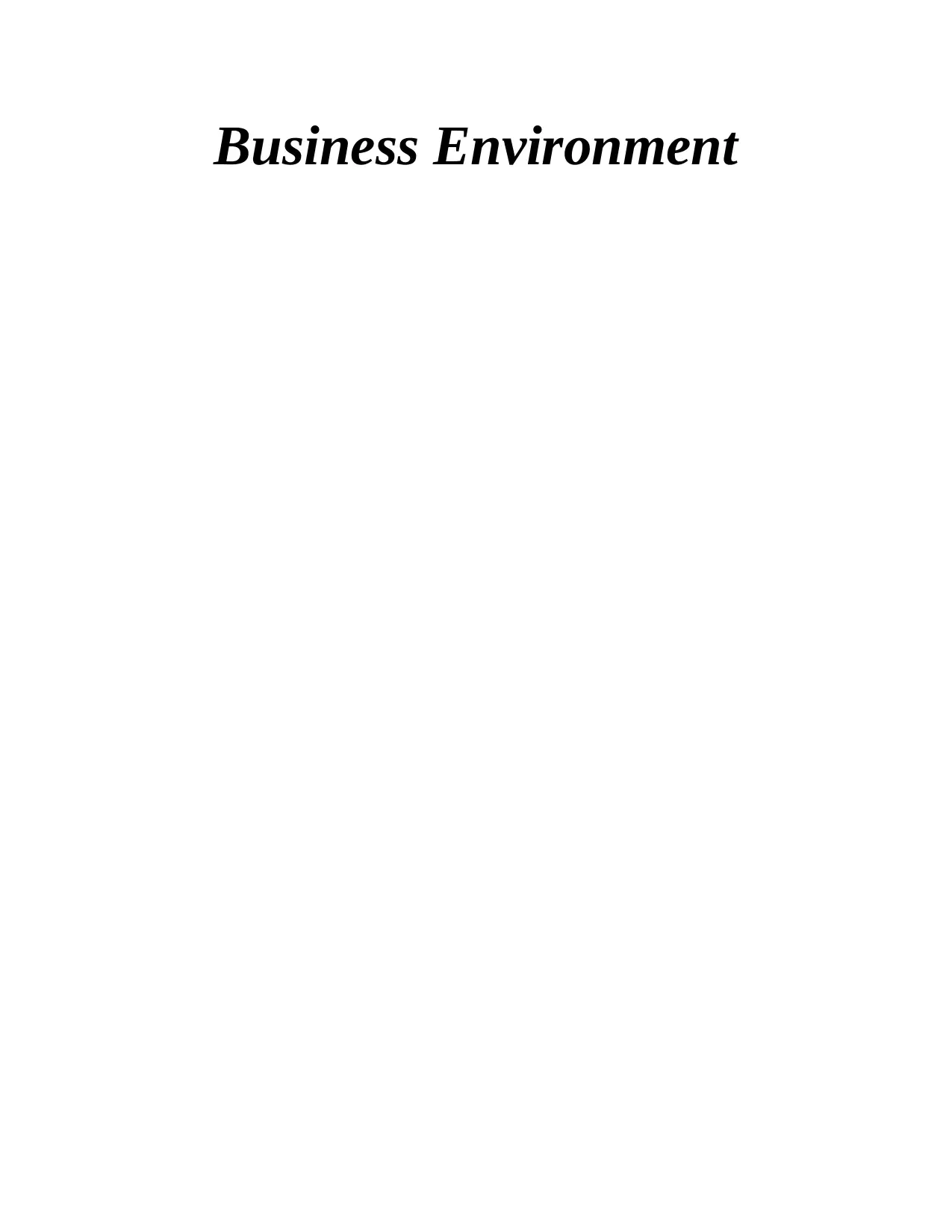
Business Environment
Paraphrase This Document
Need a fresh take? Get an instant paraphrase of this document with our AI Paraphraser
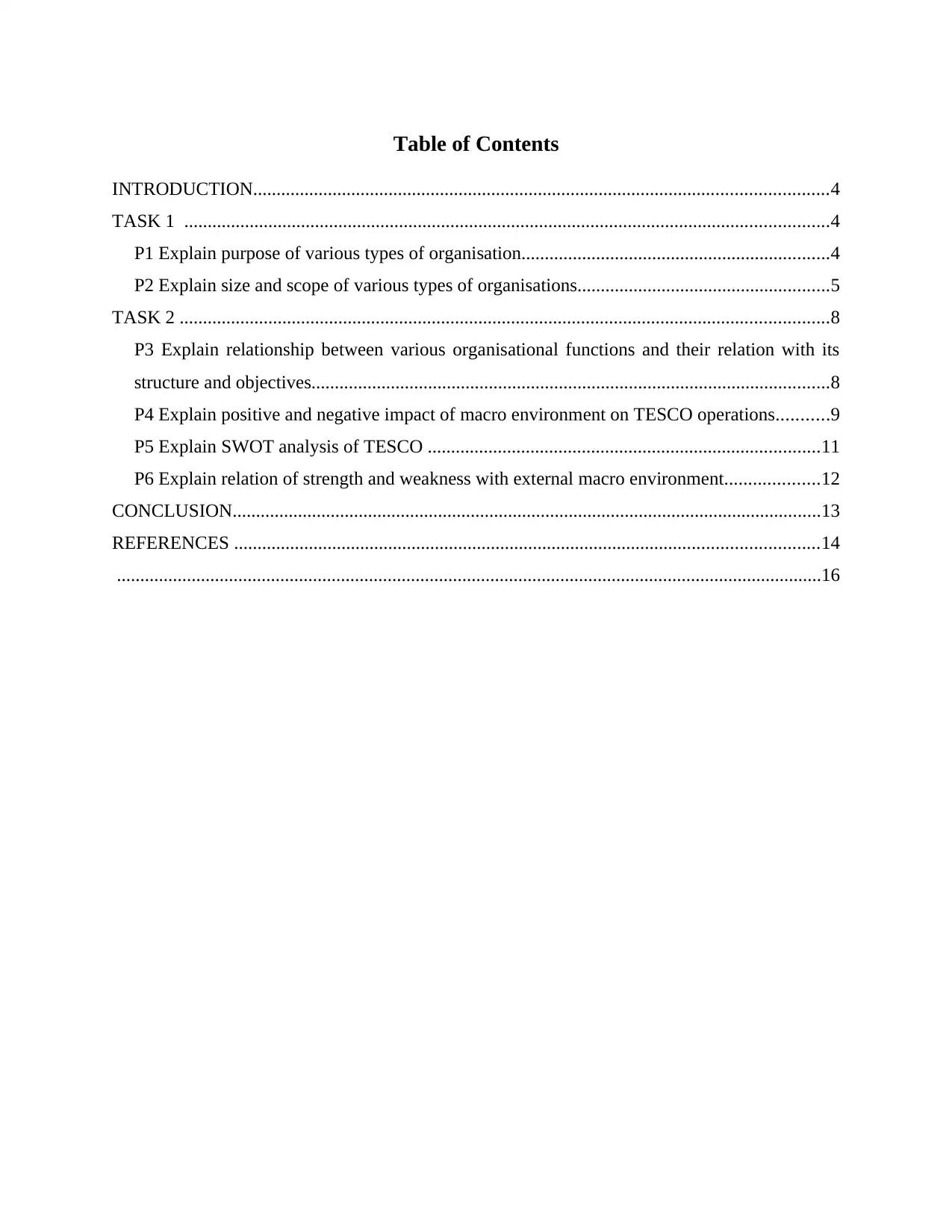
Table of Contents
INTRODUCTION...........................................................................................................................4
TASK 1 ..........................................................................................................................................4
P1 Explain purpose of various types of organisation..................................................................4
P2 Explain size and scope of various types of organisations......................................................5
TASK 2 ...........................................................................................................................................8
P3 Explain relationship between various organisational functions and their relation with its
structure and objectives...............................................................................................................8
P4 Explain positive and negative impact of macro environment on TESCO operations...........9
P5 Explain SWOT analysis of TESCO ....................................................................................11
P6 Explain relation of strength and weakness with external macro environment....................12
CONCLUSION..............................................................................................................................13
REFERENCES .............................................................................................................................14
.......................................................................................................................................................16
INTRODUCTION...........................................................................................................................4
TASK 1 ..........................................................................................................................................4
P1 Explain purpose of various types of organisation..................................................................4
P2 Explain size and scope of various types of organisations......................................................5
TASK 2 ...........................................................................................................................................8
P3 Explain relationship between various organisational functions and their relation with its
structure and objectives...............................................................................................................8
P4 Explain positive and negative impact of macro environment on TESCO operations...........9
P5 Explain SWOT analysis of TESCO ....................................................................................11
P6 Explain relation of strength and weakness with external macro environment....................12
CONCLUSION..............................................................................................................................13
REFERENCES .............................................................................................................................14
.......................................................................................................................................................16
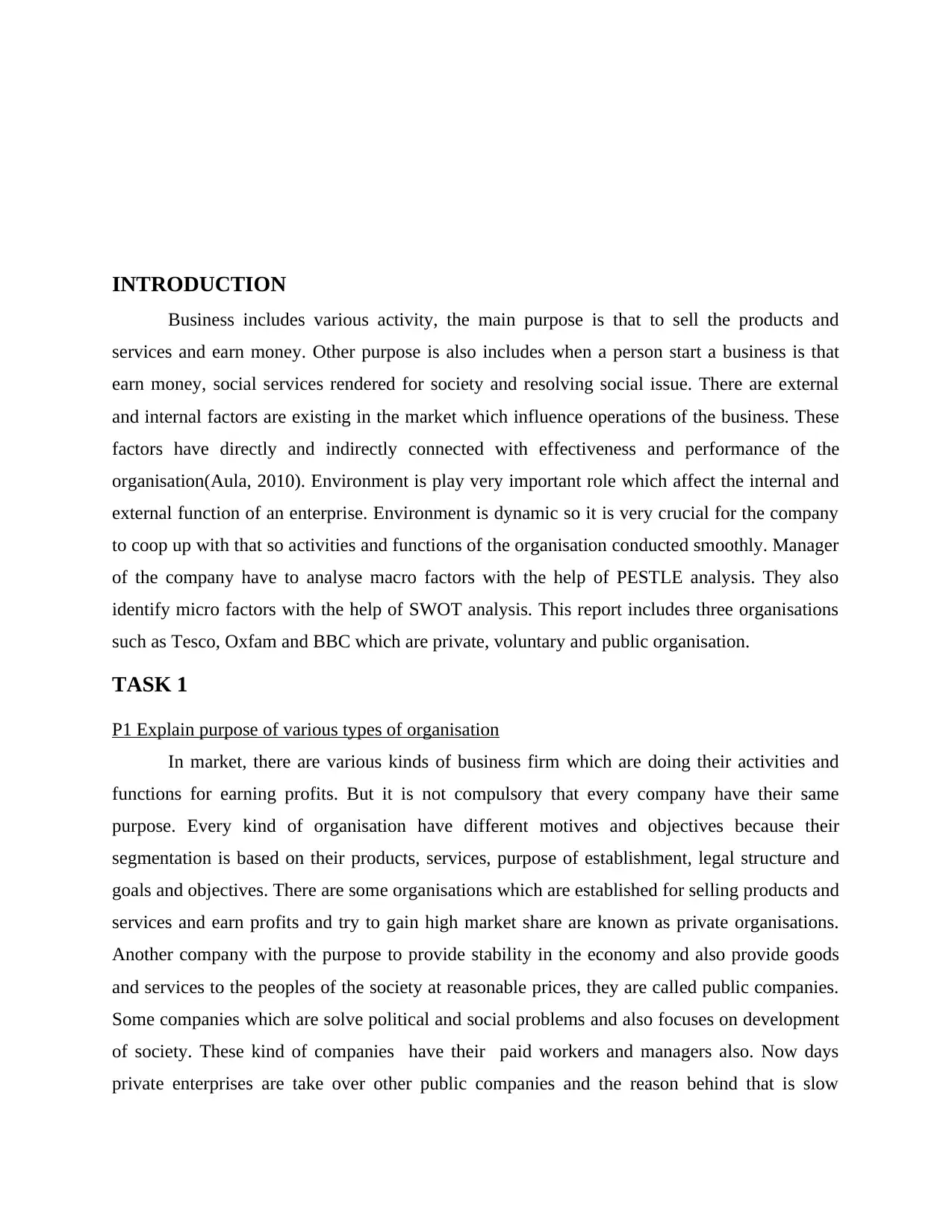
INTRODUCTION
Business includes various activity, the main purpose is that to sell the products and
services and earn money. Other purpose is also includes when a person start a business is that
earn money, social services rendered for society and resolving social issue. There are external
and internal factors are existing in the market which influence operations of the business. These
factors have directly and indirectly connected with effectiveness and performance of the
organisation(Aula, 2010). Environment is play very important role which affect the internal and
external function of an enterprise. Environment is dynamic so it is very crucial for the company
to coop up with that so activities and functions of the organisation conducted smoothly. Manager
of the company have to analyse macro factors with the help of PESTLE analysis. They also
identify micro factors with the help of SWOT analysis. This report includes three organisations
such as Tesco, Oxfam and BBC which are private, voluntary and public organisation.
TASK 1
P1 Explain purpose of various types of organisation
In market, there are various kinds of business firm which are doing their activities and
functions for earning profits. But it is not compulsory that every company have their same
purpose. Every kind of organisation have different motives and objectives because their
segmentation is based on their products, services, purpose of establishment, legal structure and
goals and objectives. There are some organisations which are established for selling products and
services and earn profits and try to gain high market share are known as private organisations.
Another company with the purpose to provide stability in the economy and also provide goods
and services to the peoples of the society at reasonable prices, they are called public companies.
Some companies which are solve political and social problems and also focuses on development
of society. These kind of companies have their paid workers and managers also. Now days
private enterprises are take over other public companies and the reason behind that is slow
Business includes various activity, the main purpose is that to sell the products and
services and earn money. Other purpose is also includes when a person start a business is that
earn money, social services rendered for society and resolving social issue. There are external
and internal factors are existing in the market which influence operations of the business. These
factors have directly and indirectly connected with effectiveness and performance of the
organisation(Aula, 2010). Environment is play very important role which affect the internal and
external function of an enterprise. Environment is dynamic so it is very crucial for the company
to coop up with that so activities and functions of the organisation conducted smoothly. Manager
of the company have to analyse macro factors with the help of PESTLE analysis. They also
identify micro factors with the help of SWOT analysis. This report includes three organisations
such as Tesco, Oxfam and BBC which are private, voluntary and public organisation.
TASK 1
P1 Explain purpose of various types of organisation
In market, there are various kinds of business firm which are doing their activities and
functions for earning profits. But it is not compulsory that every company have their same
purpose. Every kind of organisation have different motives and objectives because their
segmentation is based on their products, services, purpose of establishment, legal structure and
goals and objectives. There are some organisations which are established for selling products and
services and earn profits and try to gain high market share are known as private organisations.
Another company with the purpose to provide stability in the economy and also provide goods
and services to the peoples of the society at reasonable prices, they are called public companies.
Some companies which are solve political and social problems and also focuses on development
of society. These kind of companies have their paid workers and managers also. Now days
private enterprises are take over other public companies and the reason behind that is slow
⊘ This is a preview!⊘
Do you want full access?
Subscribe today to unlock all pages.

Trusted by 1+ million students worldwide
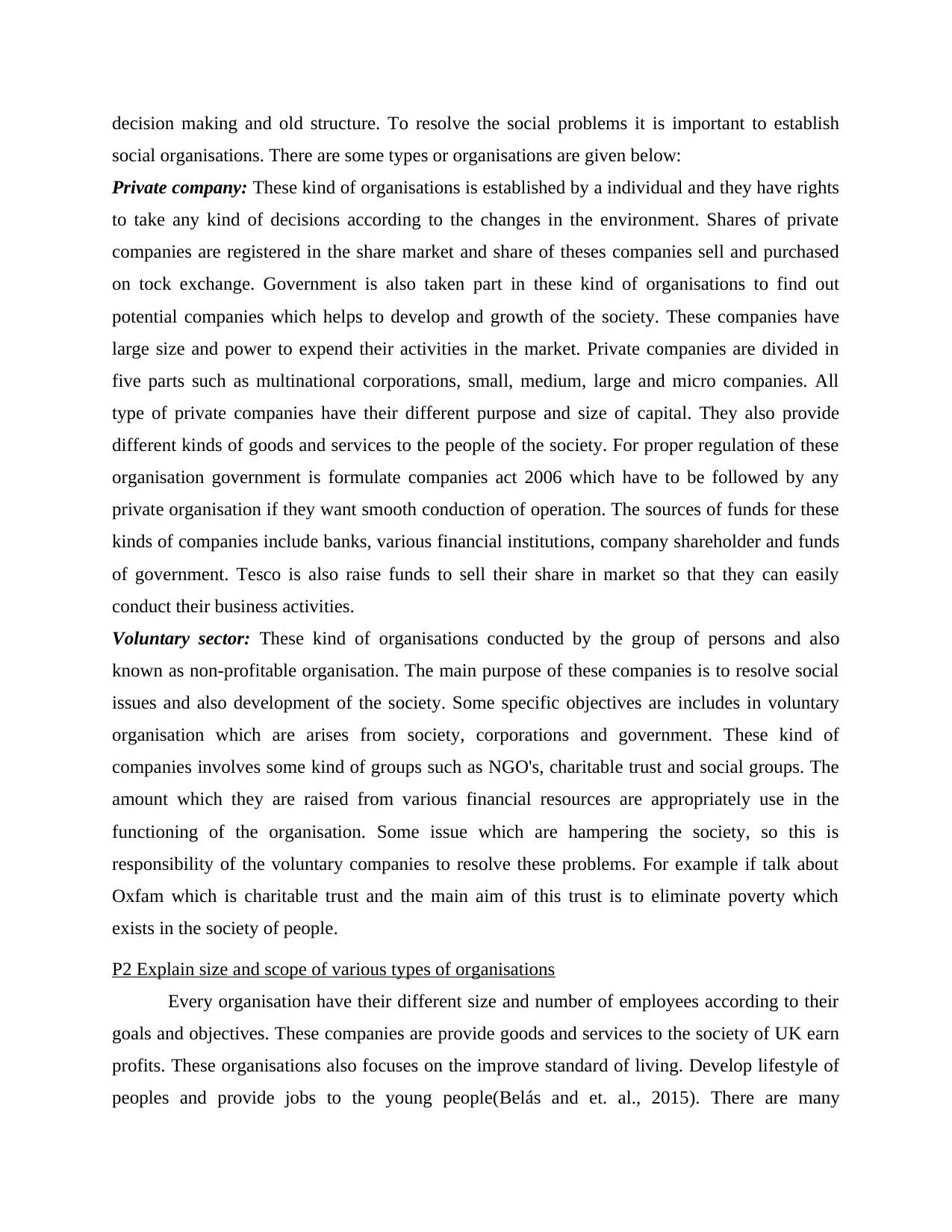
decision making and old structure. To resolve the social problems it is important to establish
social organisations. There are some types or organisations are given below:
Private company: These kind of organisations is established by a individual and they have rights
to take any kind of decisions according to the changes in the environment. Shares of private
companies are registered in the share market and share of theses companies sell and purchased
on tock exchange. Government is also taken part in these kind of organisations to find out
potential companies which helps to develop and growth of the society. These companies have
large size and power to expend their activities in the market. Private companies are divided in
five parts such as multinational corporations, small, medium, large and micro companies. All
type of private companies have their different purpose and size of capital. They also provide
different kinds of goods and services to the people of the society. For proper regulation of these
organisation government is formulate companies act 2006 which have to be followed by any
private organisation if they want smooth conduction of operation. The sources of funds for these
kinds of companies include banks, various financial institutions, company shareholder and funds
of government. Tesco is also raise funds to sell their share in market so that they can easily
conduct their business activities.
Voluntary sector: These kind of organisations conducted by the group of persons and also
known as non-profitable organisation. The main purpose of these companies is to resolve social
issues and also development of the society. Some specific objectives are includes in voluntary
organisation which are arises from society, corporations and government. These kind of
companies involves some kind of groups such as NGO's, charitable trust and social groups. The
amount which they are raised from various financial resources are appropriately use in the
functioning of the organisation. Some issue which are hampering the society, so this is
responsibility of the voluntary companies to resolve these problems. For example if talk about
Oxfam which is charitable trust and the main aim of this trust is to eliminate poverty which
exists in the society of people.
P2 Explain size and scope of various types of organisations
Every organisation have their different size and number of employees according to their
goals and objectives. These companies are provide goods and services to the society of UK earn
profits. These organisations also focuses on the improve standard of living. Develop lifestyle of
peoples and provide jobs to the young people(Belás and et. al., 2015). There are many
social organisations. There are some types or organisations are given below:
Private company: These kind of organisations is established by a individual and they have rights
to take any kind of decisions according to the changes in the environment. Shares of private
companies are registered in the share market and share of theses companies sell and purchased
on tock exchange. Government is also taken part in these kind of organisations to find out
potential companies which helps to develop and growth of the society. These companies have
large size and power to expend their activities in the market. Private companies are divided in
five parts such as multinational corporations, small, medium, large and micro companies. All
type of private companies have their different purpose and size of capital. They also provide
different kinds of goods and services to the people of the society. For proper regulation of these
organisation government is formulate companies act 2006 which have to be followed by any
private organisation if they want smooth conduction of operation. The sources of funds for these
kinds of companies include banks, various financial institutions, company shareholder and funds
of government. Tesco is also raise funds to sell their share in market so that they can easily
conduct their business activities.
Voluntary sector: These kind of organisations conducted by the group of persons and also
known as non-profitable organisation. The main purpose of these companies is to resolve social
issues and also development of the society. Some specific objectives are includes in voluntary
organisation which are arises from society, corporations and government. These kind of
companies involves some kind of groups such as NGO's, charitable trust and social groups. The
amount which they are raised from various financial resources are appropriately use in the
functioning of the organisation. Some issue which are hampering the society, so this is
responsibility of the voluntary companies to resolve these problems. For example if talk about
Oxfam which is charitable trust and the main aim of this trust is to eliminate poverty which
exists in the society of people.
P2 Explain size and scope of various types of organisations
Every organisation have their different size and number of employees according to their
goals and objectives. These companies are provide goods and services to the society of UK earn
profits. These organisations also focuses on the improve standard of living. Develop lifestyle of
peoples and provide jobs to the young people(Belás and et. al., 2015). There are many
Paraphrase This Document
Need a fresh take? Get an instant paraphrase of this document with our AI Paraphraser
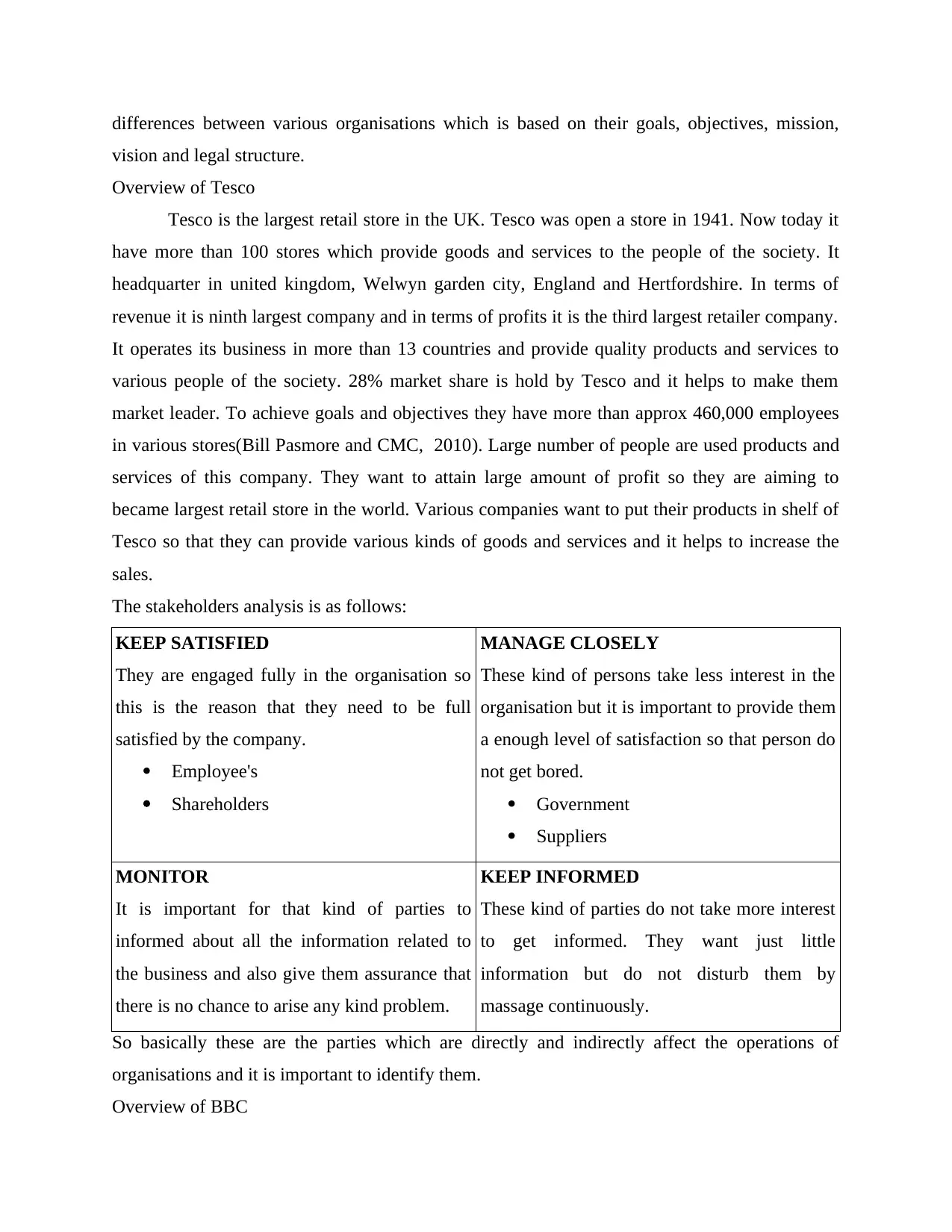
differences between various organisations which is based on their goals, objectives, mission,
vision and legal structure.
Overview of Tesco
Tesco is the largest retail store in the UK. Tesco was open a store in 1941. Now today it
have more than 100 stores which provide goods and services to the people of the society. It
headquarter in united kingdom, Welwyn garden city, England and Hertfordshire. In terms of
revenue it is ninth largest company and in terms of profits it is the third largest retailer company.
It operates its business in more than 13 countries and provide quality products and services to
various people of the society. 28% market share is hold by Tesco and it helps to make them
market leader. To achieve goals and objectives they have more than approx 460,000 employees
in various stores(Bill Pasmore and CMC, 2010). Large number of people are used products and
services of this company. They want to attain large amount of profit so they are aiming to
became largest retail store in the world. Various companies want to put their products in shelf of
Tesco so that they can provide various kinds of goods and services and it helps to increase the
sales.
The stakeholders analysis is as follows:
KEEP SATISFIED
They are engaged fully in the organisation so
this is the reason that they need to be full
satisfied by the company.
Employee's
Shareholders
MANAGE CLOSELY
These kind of persons take less interest in the
organisation but it is important to provide them
a enough level of satisfaction so that person do
not get bored.
Government
Suppliers
MONITOR
It is important for that kind of parties to
informed about all the information related to
the business and also give them assurance that
there is no chance to arise any kind problem.
KEEP INFORMED
These kind of parties do not take more interest
to get informed. They want just little
information but do not disturb them by
massage continuously.
So basically these are the parties which are directly and indirectly affect the operations of
organisations and it is important to identify them.
Overview of BBC
vision and legal structure.
Overview of Tesco
Tesco is the largest retail store in the UK. Tesco was open a store in 1941. Now today it
have more than 100 stores which provide goods and services to the people of the society. It
headquarter in united kingdom, Welwyn garden city, England and Hertfordshire. In terms of
revenue it is ninth largest company and in terms of profits it is the third largest retailer company.
It operates its business in more than 13 countries and provide quality products and services to
various people of the society. 28% market share is hold by Tesco and it helps to make them
market leader. To achieve goals and objectives they have more than approx 460,000 employees
in various stores(Bill Pasmore and CMC, 2010). Large number of people are used products and
services of this company. They want to attain large amount of profit so they are aiming to
became largest retail store in the world. Various companies want to put their products in shelf of
Tesco so that they can provide various kinds of goods and services and it helps to increase the
sales.
The stakeholders analysis is as follows:
KEEP SATISFIED
They are engaged fully in the organisation so
this is the reason that they need to be full
satisfied by the company.
Employee's
Shareholders
MANAGE CLOSELY
These kind of persons take less interest in the
organisation but it is important to provide them
a enough level of satisfaction so that person do
not get bored.
Government
Suppliers
MONITOR
It is important for that kind of parties to
informed about all the information related to
the business and also give them assurance that
there is no chance to arise any kind problem.
KEEP INFORMED
These kind of parties do not take more interest
to get informed. They want just little
information but do not disturb them by
massage continuously.
So basically these are the parties which are directly and indirectly affect the operations of
organisations and it is important to identify them.
Overview of BBC
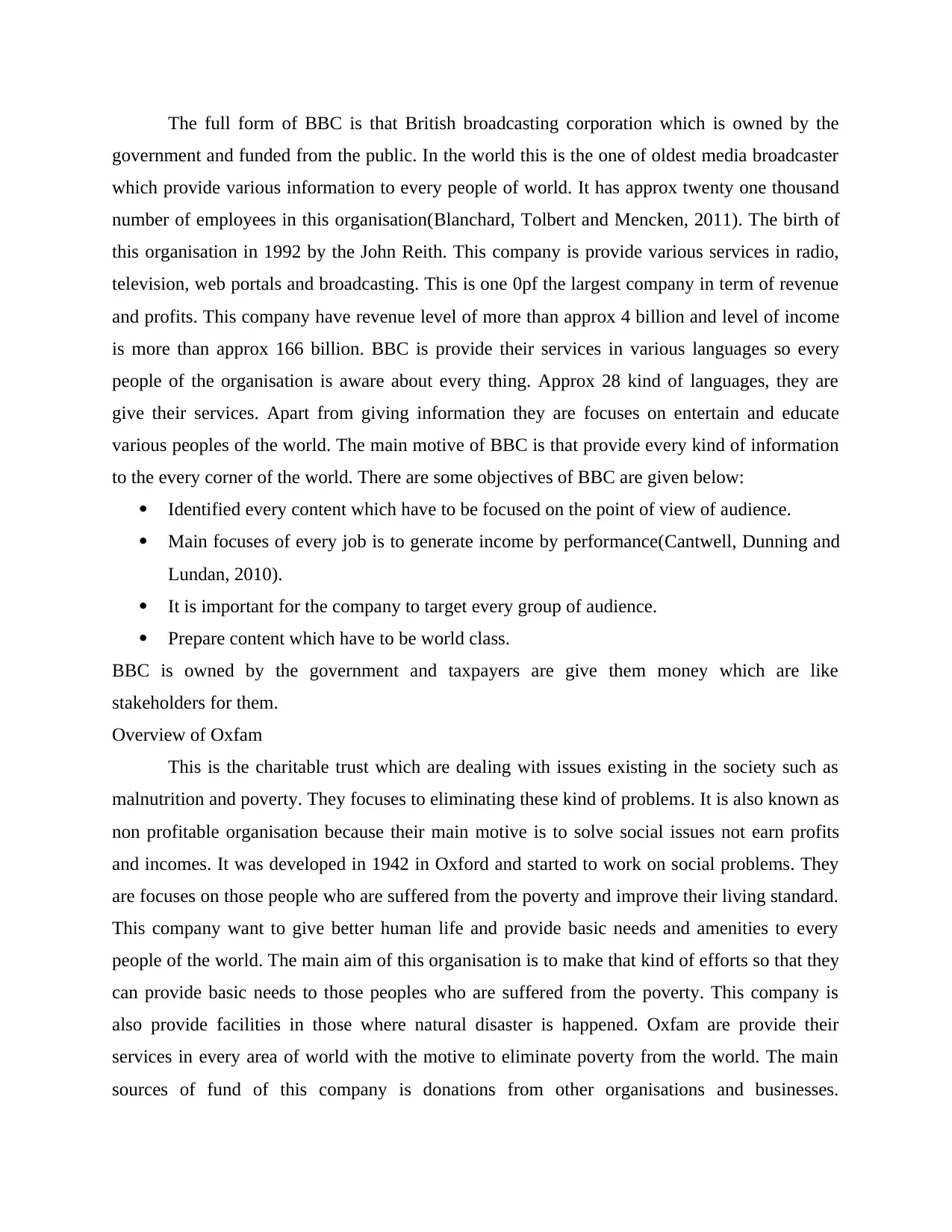
The full form of BBC is that British broadcasting corporation which is owned by the
government and funded from the public. In the world this is the one of oldest media broadcaster
which provide various information to every people of world. It has approx twenty one thousand
number of employees in this organisation(Blanchard, Tolbert and Mencken, 2011). The birth of
this organisation in 1992 by the John Reith. This company is provide various services in radio,
television, web portals and broadcasting. This is one 0pf the largest company in term of revenue
and profits. This company have revenue level of more than approx 4 billion and level of income
is more than approx 166 billion. BBC is provide their services in various languages so every
people of the organisation is aware about every thing. Approx 28 kind of languages, they are
give their services. Apart from giving information they are focuses on entertain and educate
various peoples of the world. The main motive of BBC is that provide every kind of information
to the every corner of the world. There are some objectives of BBC are given below:
Identified every content which have to be focused on the point of view of audience.
Main focuses of every job is to generate income by performance(Cantwell, Dunning and
Lundan, 2010).
It is important for the company to target every group of audience.
Prepare content which have to be world class.
BBC is owned by the government and taxpayers are give them money which are like
stakeholders for them.
Overview of Oxfam
This is the charitable trust which are dealing with issues existing in the society such as
malnutrition and poverty. They focuses to eliminating these kind of problems. It is also known as
non profitable organisation because their main motive is to solve social issues not earn profits
and incomes. It was developed in 1942 in Oxford and started to work on social problems. They
are focuses on those people who are suffered from the poverty and improve their living standard.
This company want to give better human life and provide basic needs and amenities to every
people of the world. The main aim of this organisation is to make that kind of efforts so that they
can provide basic needs to those peoples who are suffered from the poverty. This company is
also provide facilities in those where natural disaster is happened. Oxfam are provide their
services in every area of world with the motive to eliminate poverty from the world. The main
sources of fund of this company is donations from other organisations and businesses.
government and funded from the public. In the world this is the one of oldest media broadcaster
which provide various information to every people of world. It has approx twenty one thousand
number of employees in this organisation(Blanchard, Tolbert and Mencken, 2011). The birth of
this organisation in 1992 by the John Reith. This company is provide various services in radio,
television, web portals and broadcasting. This is one 0pf the largest company in term of revenue
and profits. This company have revenue level of more than approx 4 billion and level of income
is more than approx 166 billion. BBC is provide their services in various languages so every
people of the organisation is aware about every thing. Approx 28 kind of languages, they are
give their services. Apart from giving information they are focuses on entertain and educate
various peoples of the world. The main motive of BBC is that provide every kind of information
to the every corner of the world. There are some objectives of BBC are given below:
Identified every content which have to be focused on the point of view of audience.
Main focuses of every job is to generate income by performance(Cantwell, Dunning and
Lundan, 2010).
It is important for the company to target every group of audience.
Prepare content which have to be world class.
BBC is owned by the government and taxpayers are give them money which are like
stakeholders for them.
Overview of Oxfam
This is the charitable trust which are dealing with issues existing in the society such as
malnutrition and poverty. They focuses to eliminating these kind of problems. It is also known as
non profitable organisation because their main motive is to solve social issues not earn profits
and incomes. It was developed in 1942 in Oxford and started to work on social problems. They
are focuses on those people who are suffered from the poverty and improve their living standard.
This company want to give better human life and provide basic needs and amenities to every
people of the world. The main aim of this organisation is to make that kind of efforts so that they
can provide basic needs to those peoples who are suffered from the poverty. This company is
also provide facilities in those where natural disaster is happened. Oxfam are provide their
services in every area of world with the motive to eliminate poverty from the world. The main
sources of fund of this company is donations from other organisations and businesses.
⊘ This is a preview!⊘
Do you want full access?
Subscribe today to unlock all pages.

Trusted by 1+ million students worldwide
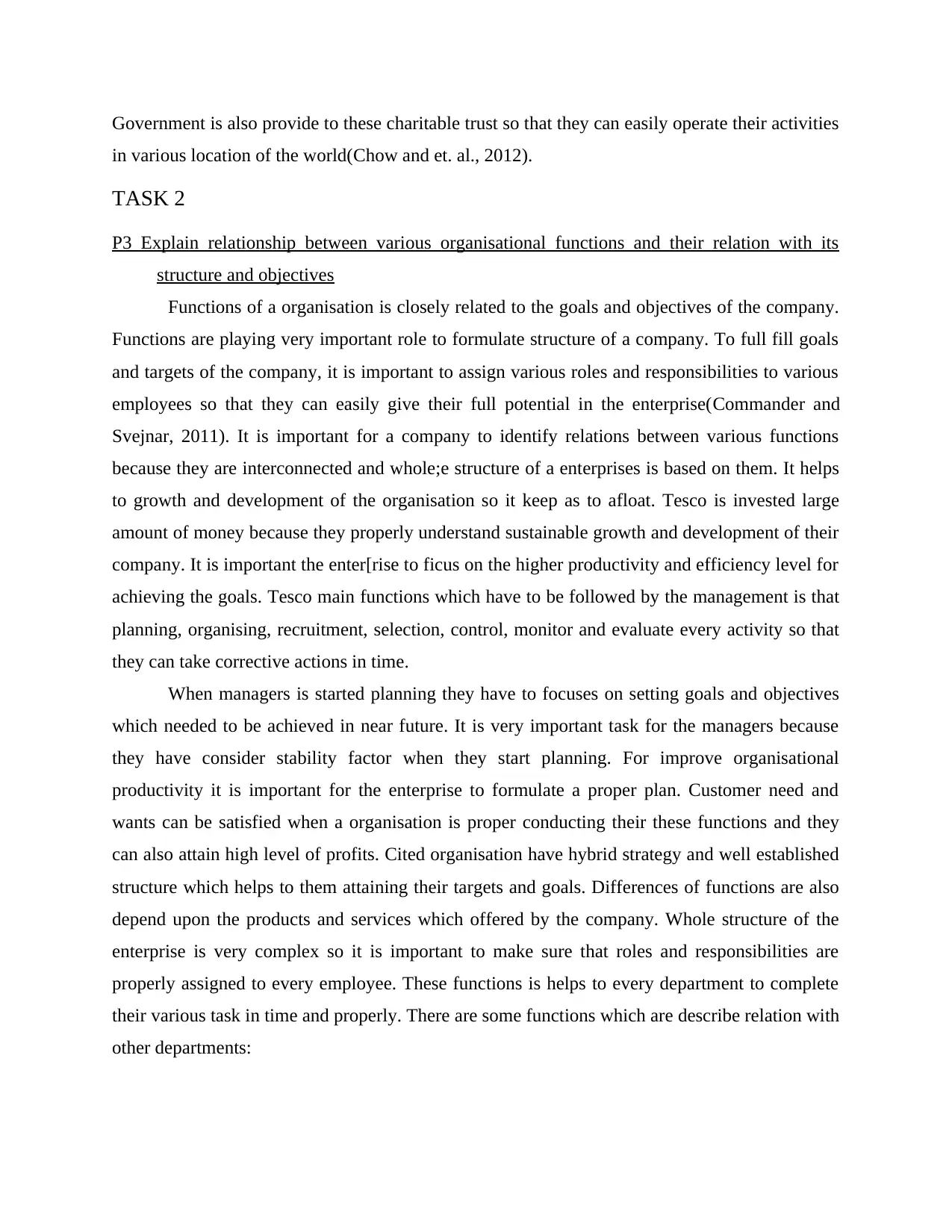
Government is also provide to these charitable trust so that they can easily operate their activities
in various location of the world(Chow and et. al., 2012).
TASK 2
P3 Explain relationship between various organisational functions and their relation with its
structure and objectives
Functions of a organisation is closely related to the goals and objectives of the company.
Functions are playing very important role to formulate structure of a company. To full fill goals
and targets of the company, it is important to assign various roles and responsibilities to various
employees so that they can easily give their full potential in the enterprise(Commander and
Svejnar, 2011). It is important for a company to identify relations between various functions
because they are interconnected and whole;e structure of a enterprises is based on them. It helps
to growth and development of the organisation so it keep as to afloat. Tesco is invested large
amount of money because they properly understand sustainable growth and development of their
company. It is important the enter[rise to ficus on the higher productivity and efficiency level for
achieving the goals. Tesco main functions which have to be followed by the management is that
planning, organising, recruitment, selection, control, monitor and evaluate every activity so that
they can take corrective actions in time.
When managers is started planning they have to focuses on setting goals and objectives
which needed to be achieved in near future. It is very important task for the managers because
they have consider stability factor when they start planning. For improve organisational
productivity it is important for the enterprise to formulate a proper plan. Customer need and
wants can be satisfied when a organisation is proper conducting their these functions and they
can also attain high level of profits. Cited organisation have hybrid strategy and well established
structure which helps to them attaining their targets and goals. Differences of functions are also
depend upon the products and services which offered by the company. Whole structure of the
enterprise is very complex so it is important to make sure that roles and responsibilities are
properly assigned to every employee. These functions is helps to every department to complete
their various task in time and properly. There are some functions which are describe relation with
other departments:
in various location of the world(Chow and et. al., 2012).
TASK 2
P3 Explain relationship between various organisational functions and their relation with its
structure and objectives
Functions of a organisation is closely related to the goals and objectives of the company.
Functions are playing very important role to formulate structure of a company. To full fill goals
and targets of the company, it is important to assign various roles and responsibilities to various
employees so that they can easily give their full potential in the enterprise(Commander and
Svejnar, 2011). It is important for a company to identify relations between various functions
because they are interconnected and whole;e structure of a enterprises is based on them. It helps
to growth and development of the organisation so it keep as to afloat. Tesco is invested large
amount of money because they properly understand sustainable growth and development of their
company. It is important the enter[rise to ficus on the higher productivity and efficiency level for
achieving the goals. Tesco main functions which have to be followed by the management is that
planning, organising, recruitment, selection, control, monitor and evaluate every activity so that
they can take corrective actions in time.
When managers is started planning they have to focuses on setting goals and objectives
which needed to be achieved in near future. It is very important task for the managers because
they have consider stability factor when they start planning. For improve organisational
productivity it is important for the enterprise to formulate a proper plan. Customer need and
wants can be satisfied when a organisation is proper conducting their these functions and they
can also attain high level of profits. Cited organisation have hybrid strategy and well established
structure which helps to them attaining their targets and goals. Differences of functions are also
depend upon the products and services which offered by the company. Whole structure of the
enterprise is very complex so it is important to make sure that roles and responsibilities are
properly assigned to every employee. These functions is helps to every department to complete
their various task in time and properly. There are some functions which are describe relation with
other departments:
Paraphrase This Document
Need a fresh take? Get an instant paraphrase of this document with our AI Paraphraser
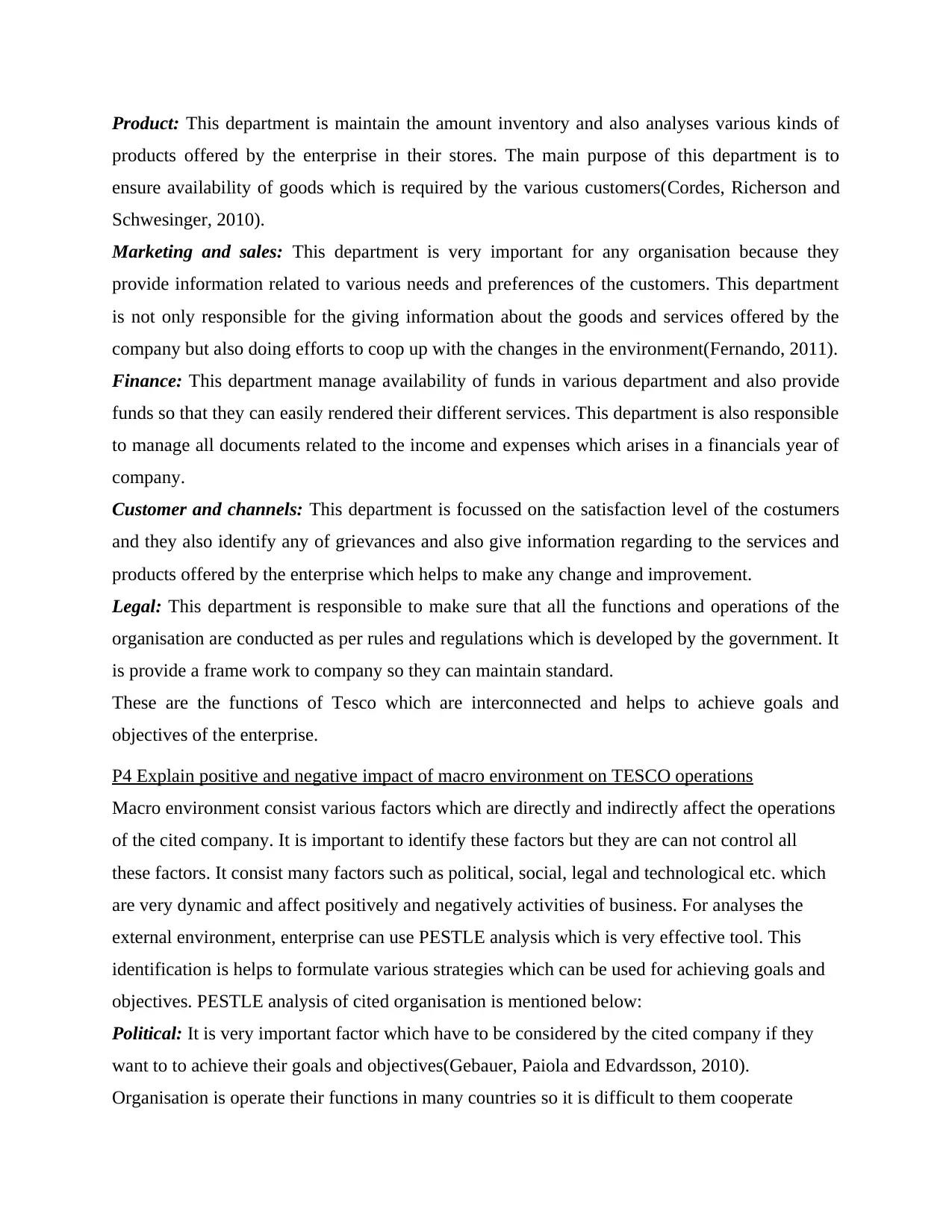
Product: This department is maintain the amount inventory and also analyses various kinds of
products offered by the enterprise in their stores. The main purpose of this department is to
ensure availability of goods which is required by the various customers(Cordes, Richerson and
Schwesinger, 2010).
Marketing and sales: This department is very important for any organisation because they
provide information related to various needs and preferences of the customers. This department
is not only responsible for the giving information about the goods and services offered by the
company but also doing efforts to coop up with the changes in the environment(Fernando, 2011).
Finance: This department manage availability of funds in various department and also provide
funds so that they can easily rendered their different services. This department is also responsible
to manage all documents related to the income and expenses which arises in a financials year of
company.
Customer and channels: This department is focussed on the satisfaction level of the costumers
and they also identify any of grievances and also give information regarding to the services and
products offered by the enterprise which helps to make any change and improvement.
Legal: This department is responsible to make sure that all the functions and operations of the
organisation are conducted as per rules and regulations which is developed by the government. It
is provide a frame work to company so they can maintain standard.
These are the functions of Tesco which are interconnected and helps to achieve goals and
objectives of the enterprise.
P4 Explain positive and negative impact of macro environment on TESCO operations
Macro environment consist various factors which are directly and indirectly affect the operations
of the cited company. It is important to identify these factors but they are can not control all
these factors. It consist many factors such as political, social, legal and technological etc. which
are very dynamic and affect positively and negatively activities of business. For analyses the
external environment, enterprise can use PESTLE analysis which is very effective tool. This
identification is helps to formulate various strategies which can be used for achieving goals and
objectives. PESTLE analysis of cited organisation is mentioned below:
Political: It is very important factor which have to be considered by the cited company if they
want to to achieve their goals and objectives(Gebauer, Paiola and Edvardsson, 2010).
Organisation is operate their functions in many countries so it is difficult to them cooperate
products offered by the enterprise in their stores. The main purpose of this department is to
ensure availability of goods which is required by the various customers(Cordes, Richerson and
Schwesinger, 2010).
Marketing and sales: This department is very important for any organisation because they
provide information related to various needs and preferences of the customers. This department
is not only responsible for the giving information about the goods and services offered by the
company but also doing efforts to coop up with the changes in the environment(Fernando, 2011).
Finance: This department manage availability of funds in various department and also provide
funds so that they can easily rendered their different services. This department is also responsible
to manage all documents related to the income and expenses which arises in a financials year of
company.
Customer and channels: This department is focussed on the satisfaction level of the costumers
and they also identify any of grievances and also give information regarding to the services and
products offered by the enterprise which helps to make any change and improvement.
Legal: This department is responsible to make sure that all the functions and operations of the
organisation are conducted as per rules and regulations which is developed by the government. It
is provide a frame work to company so they can maintain standard.
These are the functions of Tesco which are interconnected and helps to achieve goals and
objectives of the enterprise.
P4 Explain positive and negative impact of macro environment on TESCO operations
Macro environment consist various factors which are directly and indirectly affect the operations
of the cited company. It is important to identify these factors but they are can not control all
these factors. It consist many factors such as political, social, legal and technological etc. which
are very dynamic and affect positively and negatively activities of business. For analyses the
external environment, enterprise can use PESTLE analysis which is very effective tool. This
identification is helps to formulate various strategies which can be used for achieving goals and
objectives. PESTLE analysis of cited organisation is mentioned below:
Political: It is very important factor which have to be considered by the cited company if they
want to to achieve their goals and objectives(Gebauer, Paiola and Edvardsson, 2010).
Organisation is operate their functions in many countries so it is difficult to them cooperate
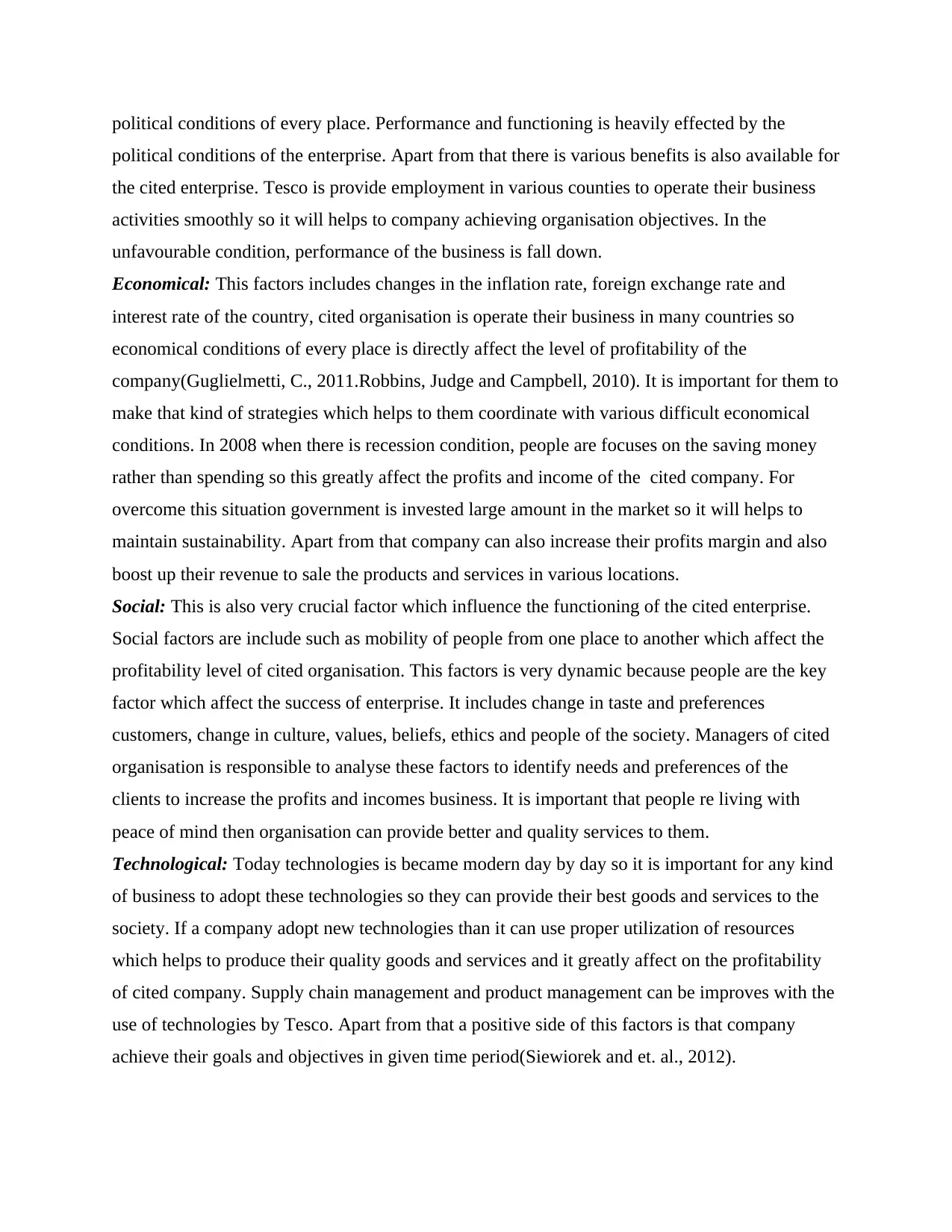
political conditions of every place. Performance and functioning is heavily effected by the
political conditions of the enterprise. Apart from that there is various benefits is also available for
the cited enterprise. Tesco is provide employment in various counties to operate their business
activities smoothly so it will helps to company achieving organisation objectives. In the
unfavourable condition, performance of the business is fall down.
Economical: This factors includes changes in the inflation rate, foreign exchange rate and
interest rate of the country, cited organisation is operate their business in many countries so
economical conditions of every place is directly affect the level of profitability of the
company(Guglielmetti, C., 2011.Robbins, Judge and Campbell, 2010). It is important for them to
make that kind of strategies which helps to them coordinate with various difficult economical
conditions. In 2008 when there is recession condition, people are focuses on the saving money
rather than spending so this greatly affect the profits and income of the cited company. For
overcome this situation government is invested large amount in the market so it will helps to
maintain sustainability. Apart from that company can also increase their profits margin and also
boost up their revenue to sale the products and services in various locations.
Social: This is also very crucial factor which influence the functioning of the cited enterprise.
Social factors are include such as mobility of people from one place to another which affect the
profitability level of cited organisation. This factors is very dynamic because people are the key
factor which affect the success of enterprise. It includes change in taste and preferences
customers, change in culture, values, beliefs, ethics and people of the society. Managers of cited
organisation is responsible to analyse these factors to identify needs and preferences of the
clients to increase the profits and incomes business. It is important that people re living with
peace of mind then organisation can provide better and quality services to them.
Technological: Today technologies is became modern day by day so it is important for any kind
of business to adopt these technologies so they can provide their best goods and services to the
society. If a company adopt new technologies than it can use proper utilization of resources
which helps to produce their quality goods and services and it greatly affect on the profitability
of cited company. Supply chain management and product management can be improves with the
use of technologies by Tesco. Apart from that a positive side of this factors is that company
achieve their goals and objectives in given time period(Siewiorek and et. al., 2012).
political conditions of the enterprise. Apart from that there is various benefits is also available for
the cited enterprise. Tesco is provide employment in various counties to operate their business
activities smoothly so it will helps to company achieving organisation objectives. In the
unfavourable condition, performance of the business is fall down.
Economical: This factors includes changes in the inflation rate, foreign exchange rate and
interest rate of the country, cited organisation is operate their business in many countries so
economical conditions of every place is directly affect the level of profitability of the
company(Guglielmetti, C., 2011.Robbins, Judge and Campbell, 2010). It is important for them to
make that kind of strategies which helps to them coordinate with various difficult economical
conditions. In 2008 when there is recession condition, people are focuses on the saving money
rather than spending so this greatly affect the profits and income of the cited company. For
overcome this situation government is invested large amount in the market so it will helps to
maintain sustainability. Apart from that company can also increase their profits margin and also
boost up their revenue to sale the products and services in various locations.
Social: This is also very crucial factor which influence the functioning of the cited enterprise.
Social factors are include such as mobility of people from one place to another which affect the
profitability level of cited organisation. This factors is very dynamic because people are the key
factor which affect the success of enterprise. It includes change in taste and preferences
customers, change in culture, values, beliefs, ethics and people of the society. Managers of cited
organisation is responsible to analyse these factors to identify needs and preferences of the
clients to increase the profits and incomes business. It is important that people re living with
peace of mind then organisation can provide better and quality services to them.
Technological: Today technologies is became modern day by day so it is important for any kind
of business to adopt these technologies so they can provide their best goods and services to the
society. If a company adopt new technologies than it can use proper utilization of resources
which helps to produce their quality goods and services and it greatly affect on the profitability
of cited company. Supply chain management and product management can be improves with the
use of technologies by Tesco. Apart from that a positive side of this factors is that company
achieve their goals and objectives in given time period(Siewiorek and et. al., 2012).
⊘ This is a preview!⊘
Do you want full access?
Subscribe today to unlock all pages.

Trusted by 1+ million students worldwide
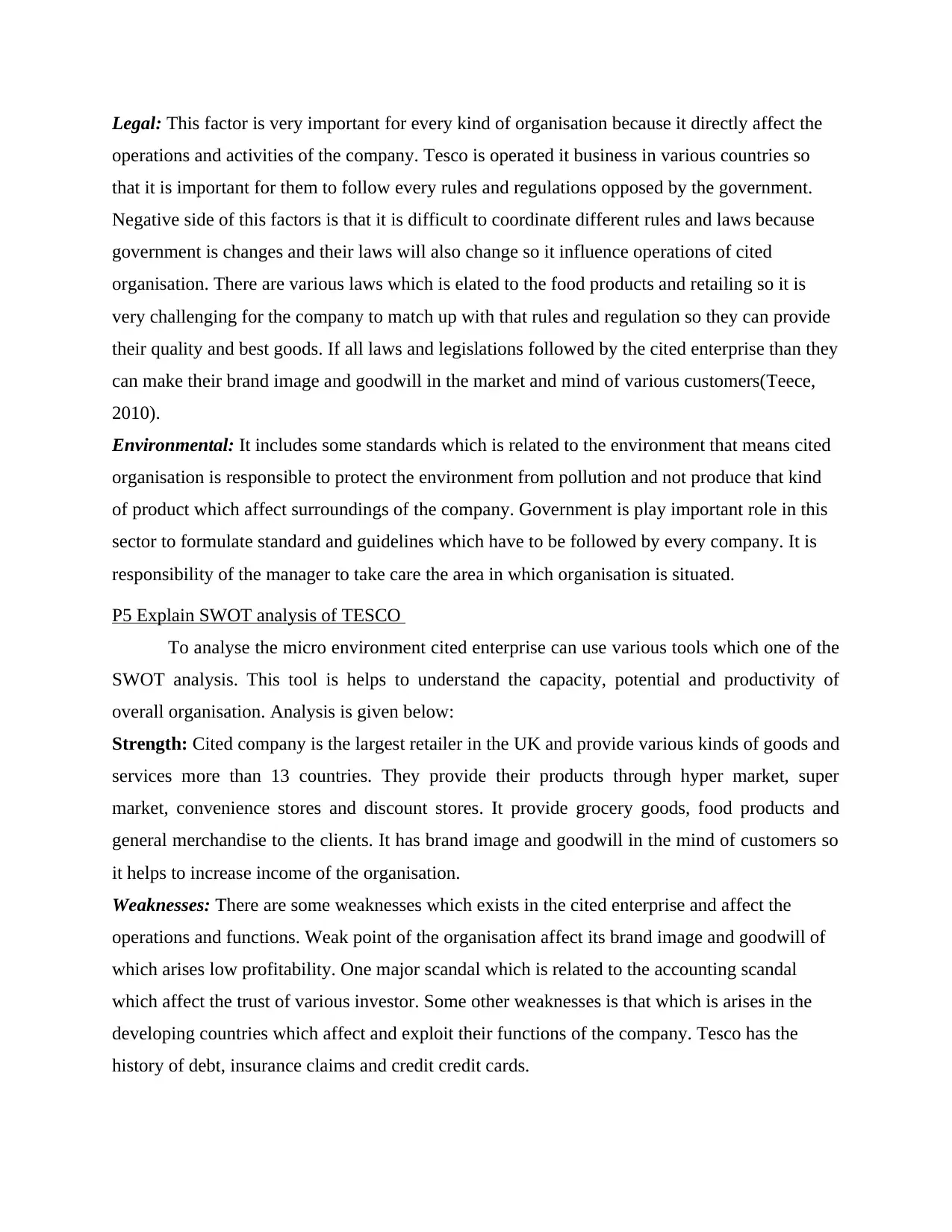
Legal: This factor is very important for every kind of organisation because it directly affect the
operations and activities of the company. Tesco is operated it business in various countries so
that it is important for them to follow every rules and regulations opposed by the government.
Negative side of this factors is that it is difficult to coordinate different rules and laws because
government is changes and their laws will also change so it influence operations of cited
organisation. There are various laws which is elated to the food products and retailing so it is
very challenging for the company to match up with that rules and regulation so they can provide
their quality and best goods. If all laws and legislations followed by the cited enterprise than they
can make their brand image and goodwill in the market and mind of various customers(Teece,
2010).
Environmental: It includes some standards which is related to the environment that means cited
organisation is responsible to protect the environment from pollution and not produce that kind
of product which affect surroundings of the company. Government is play important role in this
sector to formulate standard and guidelines which have to be followed by every company. It is
responsibility of the manager to take care the area in which organisation is situated.
P5 Explain SWOT analysis of TESCO
To analyse the micro environment cited enterprise can use various tools which one of the
SWOT analysis. This tool is helps to understand the capacity, potential and productivity of
overall organisation. Analysis is given below:
Strength: Cited company is the largest retailer in the UK and provide various kinds of goods and
services more than 13 countries. They provide their products through hyper market, super
market, convenience stores and discount stores. It provide grocery goods, food products and
general merchandise to the clients. It has brand image and goodwill in the mind of customers so
it helps to increase income of the organisation.
Weaknesses: There are some weaknesses which exists in the cited enterprise and affect the
operations and functions. Weak point of the organisation affect its brand image and goodwill of
which arises low profitability. One major scandal which is related to the accounting scandal
which affect the trust of various investor. Some other weaknesses is that which is arises in the
developing countries which affect and exploit their functions of the company. Tesco has the
history of debt, insurance claims and credit credit cards.
operations and activities of the company. Tesco is operated it business in various countries so
that it is important for them to follow every rules and regulations opposed by the government.
Negative side of this factors is that it is difficult to coordinate different rules and laws because
government is changes and their laws will also change so it influence operations of cited
organisation. There are various laws which is elated to the food products and retailing so it is
very challenging for the company to match up with that rules and regulation so they can provide
their quality and best goods. If all laws and legislations followed by the cited enterprise than they
can make their brand image and goodwill in the market and mind of various customers(Teece,
2010).
Environmental: It includes some standards which is related to the environment that means cited
organisation is responsible to protect the environment from pollution and not produce that kind
of product which affect surroundings of the company. Government is play important role in this
sector to formulate standard and guidelines which have to be followed by every company. It is
responsibility of the manager to take care the area in which organisation is situated.
P5 Explain SWOT analysis of TESCO
To analyse the micro environment cited enterprise can use various tools which one of the
SWOT analysis. This tool is helps to understand the capacity, potential and productivity of
overall organisation. Analysis is given below:
Strength: Cited company is the largest retailer in the UK and provide various kinds of goods and
services more than 13 countries. They provide their products through hyper market, super
market, convenience stores and discount stores. It provide grocery goods, food products and
general merchandise to the clients. It has brand image and goodwill in the mind of customers so
it helps to increase income of the organisation.
Weaknesses: There are some weaknesses which exists in the cited enterprise and affect the
operations and functions. Weak point of the organisation affect its brand image and goodwill of
which arises low profitability. One major scandal which is related to the accounting scandal
which affect the trust of various investor. Some other weaknesses is that which is arises in the
developing countries which affect and exploit their functions of the company. Tesco has the
history of debt, insurance claims and credit credit cards.
Paraphrase This Document
Need a fresh take? Get an instant paraphrase of this document with our AI Paraphraser
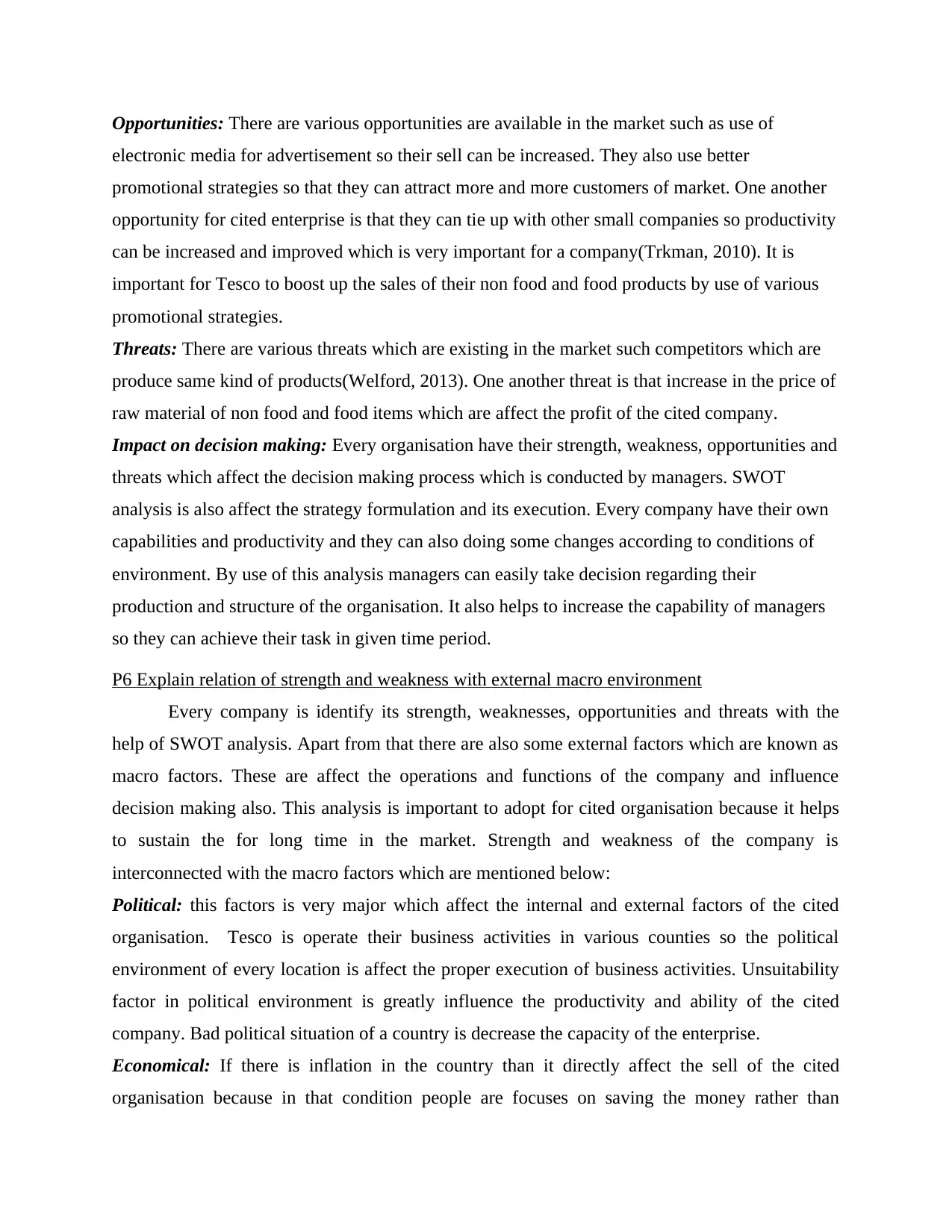
Opportunities: There are various opportunities are available in the market such as use of
electronic media for advertisement so their sell can be increased. They also use better
promotional strategies so that they can attract more and more customers of market. One another
opportunity for cited enterprise is that they can tie up with other small companies so productivity
can be increased and improved which is very important for a company(Trkman, 2010). It is
important for Tesco to boost up the sales of their non food and food products by use of various
promotional strategies.
Threats: There are various threats which are existing in the market such competitors which are
produce same kind of products(Welford, 2013). One another threat is that increase in the price of
raw material of non food and food items which are affect the profit of the cited company.
Impact on decision making: Every organisation have their strength, weakness, opportunities and
threats which affect the decision making process which is conducted by managers. SWOT
analysis is also affect the strategy formulation and its execution. Every company have their own
capabilities and productivity and they can also doing some changes according to conditions of
environment. By use of this analysis managers can easily take decision regarding their
production and structure of the organisation. It also helps to increase the capability of managers
so they can achieve their task in given time period.
P6 Explain relation of strength and weakness with external macro environment
Every company is identify its strength, weaknesses, opportunities and threats with the
help of SWOT analysis. Apart from that there are also some external factors which are known as
macro factors. These are affect the operations and functions of the company and influence
decision making also. This analysis is important to adopt for cited organisation because it helps
to sustain the for long time in the market. Strength and weakness of the company is
interconnected with the macro factors which are mentioned below:
Political: this factors is very major which affect the internal and external factors of the cited
organisation. Tesco is operate their business activities in various counties so the political
environment of every location is affect the proper execution of business activities. Unsuitability
factor in political environment is greatly influence the productivity and ability of the cited
company. Bad political situation of a country is decrease the capacity of the enterprise.
Economical: If there is inflation in the country than it directly affect the sell of the cited
organisation because in that condition people are focuses on saving the money rather than
electronic media for advertisement so their sell can be increased. They also use better
promotional strategies so that they can attract more and more customers of market. One another
opportunity for cited enterprise is that they can tie up with other small companies so productivity
can be increased and improved which is very important for a company(Trkman, 2010). It is
important for Tesco to boost up the sales of their non food and food products by use of various
promotional strategies.
Threats: There are various threats which are existing in the market such competitors which are
produce same kind of products(Welford, 2013). One another threat is that increase in the price of
raw material of non food and food items which are affect the profit of the cited company.
Impact on decision making: Every organisation have their strength, weakness, opportunities and
threats which affect the decision making process which is conducted by managers. SWOT
analysis is also affect the strategy formulation and its execution. Every company have their own
capabilities and productivity and they can also doing some changes according to conditions of
environment. By use of this analysis managers can easily take decision regarding their
production and structure of the organisation. It also helps to increase the capability of managers
so they can achieve their task in given time period.
P6 Explain relation of strength and weakness with external macro environment
Every company is identify its strength, weaknesses, opportunities and threats with the
help of SWOT analysis. Apart from that there are also some external factors which are known as
macro factors. These are affect the operations and functions of the company and influence
decision making also. This analysis is important to adopt for cited organisation because it helps
to sustain the for long time in the market. Strength and weakness of the company is
interconnected with the macro factors which are mentioned below:
Political: this factors is very major which affect the internal and external factors of the cited
organisation. Tesco is operate their business activities in various counties so the political
environment of every location is affect the proper execution of business activities. Unsuitability
factor in political environment is greatly influence the productivity and ability of the cited
company. Bad political situation of a country is decrease the capacity of the enterprise.
Economical: If there is inflation in the country than it directly affect the sell of the cited
organisation because in that condition people are focuses on saving the money rather than
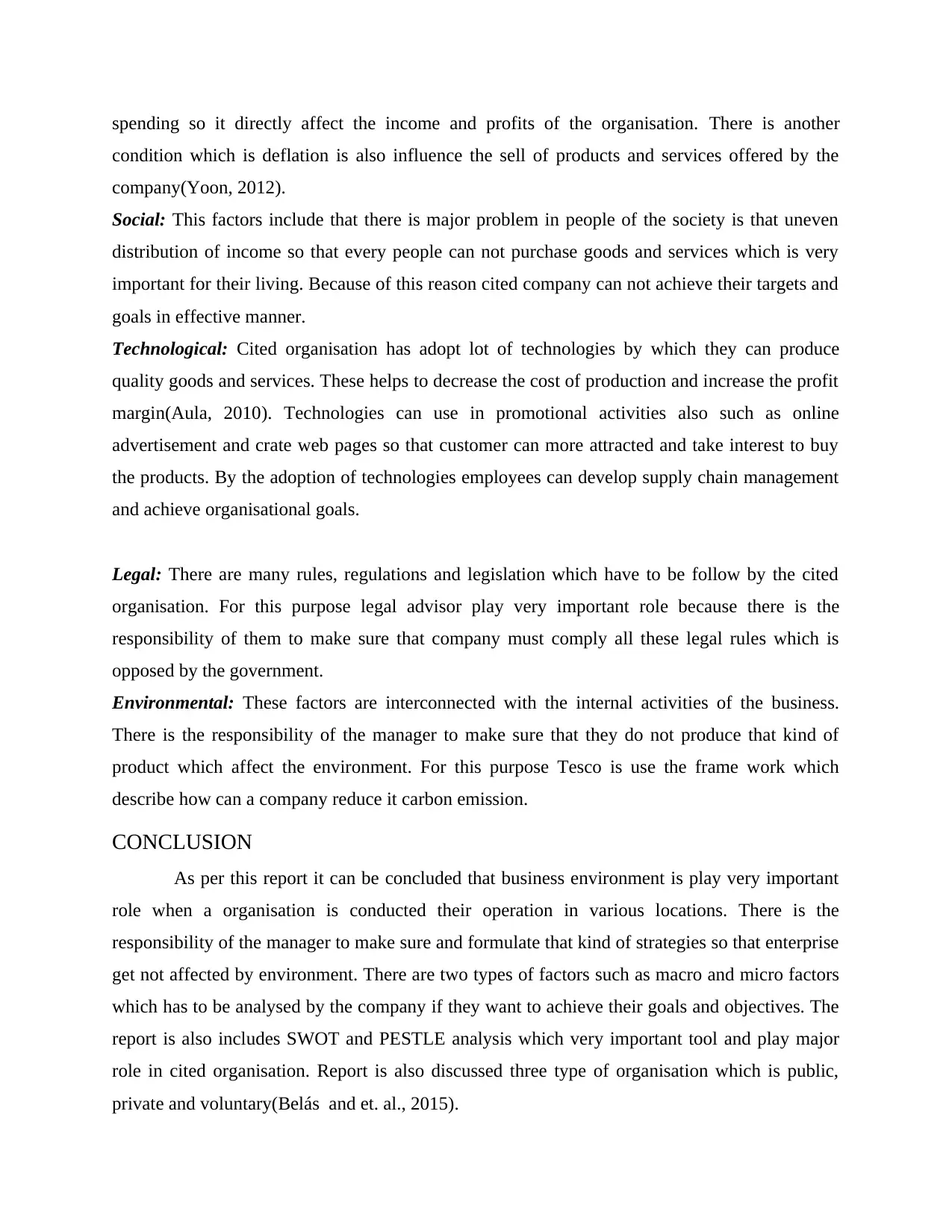
spending so it directly affect the income and profits of the organisation. There is another
condition which is deflation is also influence the sell of products and services offered by the
company(Yoon, 2012).
Social: This factors include that there is major problem in people of the society is that uneven
distribution of income so that every people can not purchase goods and services which is very
important for their living. Because of this reason cited company can not achieve their targets and
goals in effective manner.
Technological: Cited organisation has adopt lot of technologies by which they can produce
quality goods and services. These helps to decrease the cost of production and increase the profit
margin(Aula, 2010). Technologies can use in promotional activities also such as online
advertisement and crate web pages so that customer can more attracted and take interest to buy
the products. By the adoption of technologies employees can develop supply chain management
and achieve organisational goals.
Legal: There are many rules, regulations and legislation which have to be follow by the cited
organisation. For this purpose legal advisor play very important role because there is the
responsibility of them to make sure that company must comply all these legal rules which is
opposed by the government.
Environmental: These factors are interconnected with the internal activities of the business.
There is the responsibility of the manager to make sure that they do not produce that kind of
product which affect the environment. For this purpose Tesco is use the frame work which
describe how can a company reduce it carbon emission.
CONCLUSION
As per this report it can be concluded that business environment is play very important
role when a organisation is conducted their operation in various locations. There is the
responsibility of the manager to make sure and formulate that kind of strategies so that enterprise
get not affected by environment. There are two types of factors such as macro and micro factors
which has to be analysed by the company if they want to achieve their goals and objectives. The
report is also includes SWOT and PESTLE analysis which very important tool and play major
role in cited organisation. Report is also discussed three type of organisation which is public,
private and voluntary(Belás and et. al., 2015).
condition which is deflation is also influence the sell of products and services offered by the
company(Yoon, 2012).
Social: This factors include that there is major problem in people of the society is that uneven
distribution of income so that every people can not purchase goods and services which is very
important for their living. Because of this reason cited company can not achieve their targets and
goals in effective manner.
Technological: Cited organisation has adopt lot of technologies by which they can produce
quality goods and services. These helps to decrease the cost of production and increase the profit
margin(Aula, 2010). Technologies can use in promotional activities also such as online
advertisement and crate web pages so that customer can more attracted and take interest to buy
the products. By the adoption of technologies employees can develop supply chain management
and achieve organisational goals.
Legal: There are many rules, regulations and legislation which have to be follow by the cited
organisation. For this purpose legal advisor play very important role because there is the
responsibility of them to make sure that company must comply all these legal rules which is
opposed by the government.
Environmental: These factors are interconnected with the internal activities of the business.
There is the responsibility of the manager to make sure that they do not produce that kind of
product which affect the environment. For this purpose Tesco is use the frame work which
describe how can a company reduce it carbon emission.
CONCLUSION
As per this report it can be concluded that business environment is play very important
role when a organisation is conducted their operation in various locations. There is the
responsibility of the manager to make sure and formulate that kind of strategies so that enterprise
get not affected by environment. There are two types of factors such as macro and micro factors
which has to be analysed by the company if they want to achieve their goals and objectives. The
report is also includes SWOT and PESTLE analysis which very important tool and play major
role in cited organisation. Report is also discussed three type of organisation which is public,
private and voluntary(Belás and et. al., 2015).
⊘ This is a preview!⊘
Do you want full access?
Subscribe today to unlock all pages.

Trusted by 1+ million students worldwide
1 out of 15
Related Documents
Your All-in-One AI-Powered Toolkit for Academic Success.
+13062052269
info@desklib.com
Available 24*7 on WhatsApp / Email
![[object Object]](/_next/static/media/star-bottom.7253800d.svg)
Unlock your academic potential
Copyright © 2020–2025 A2Z Services. All Rights Reserved. Developed and managed by ZUCOL.





